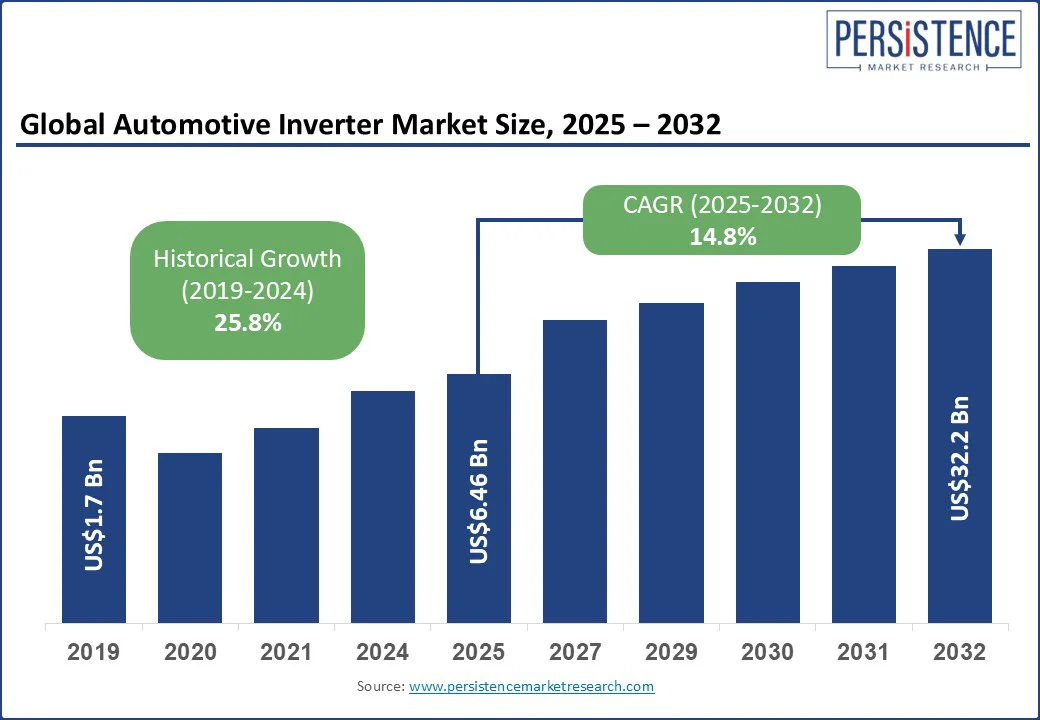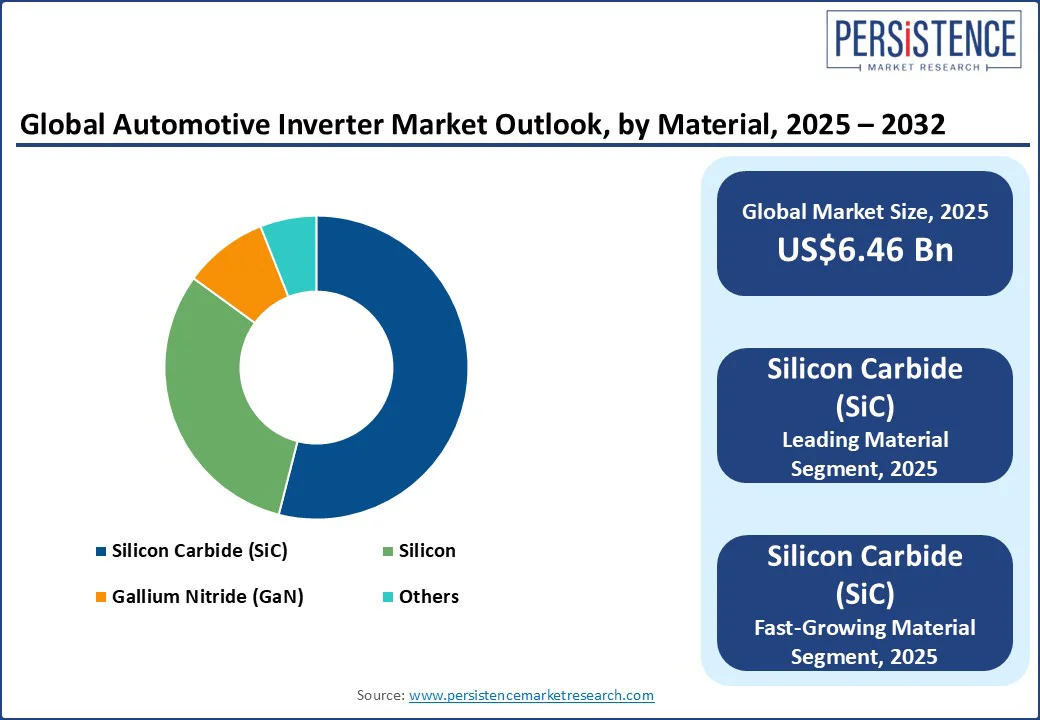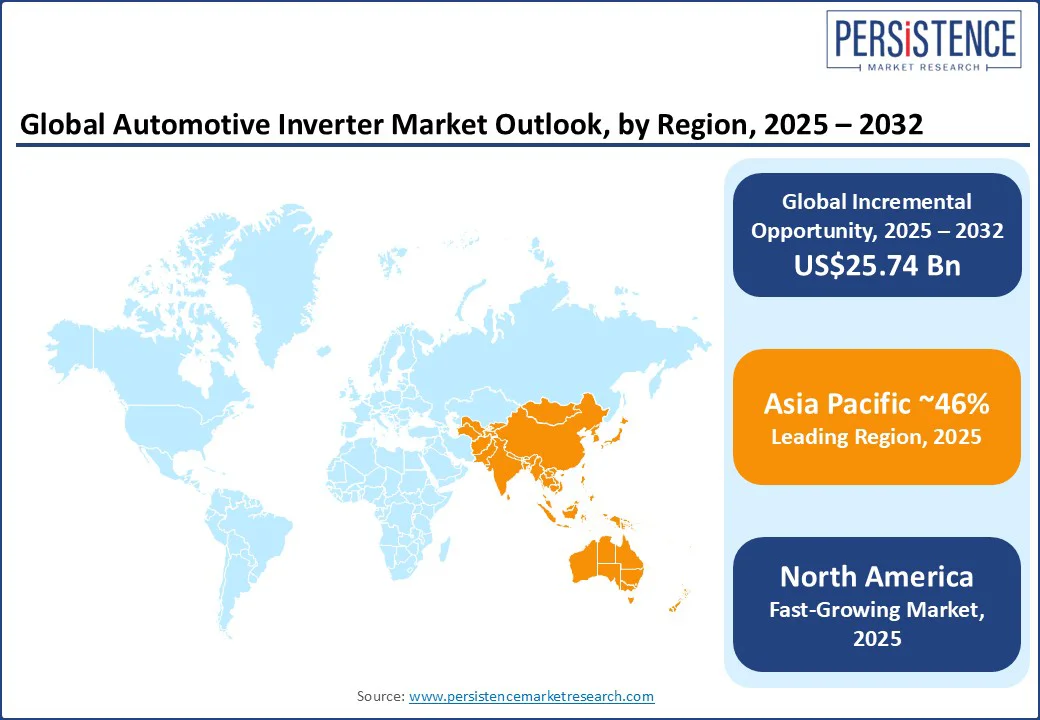ID: PMRREP35559| 173 Pages | 12 Aug 2025 | Format: PDF, Excel, PPT* | Automotive & Transportation

The global automotive inverter market size is likely to be valued at US$ 6.46 Bn in 2025 and is projected to reach US$ 32.2 Bn by 2032, growing at a CAGR of 25.8% during the forecast period from 2025 to 2032. The introduction of vehicle-to-grid (V2G) systems and the development of bi-directional inverters are generating highly lucrative business opportunities for the auto industry and the energy sector, creating significant growth prospects for market participants. Automotive inverters are responsible for converting DC power from the battery into AC power to power the electric motor. Forming the backbone of propulsion systems in electric vehicles (EVs) and hybrid electric vehicles (HEVs), inverters directly influence vehicle efficiency, performance, and thermal management. With the shift toward high-voltage platforms and wide-bandgap semiconductors, the role of inverters has gone beyond just facilitating power conversion, enabling faster charging, lighter designs, and longer driving ranges.

Key Industry Highlights
|
Global Market Attribute |
Key Insights |
|
Automotive Inverter Market Size (2025E) |
US$ 6.46 Bn |
|
Market Value Forecast (2032F) |
US$ 32.2 Bn |
|
Projected Growth (CAGR 2025 to 2032) |
25.8% |
|
Historical Market Growth (CAGR 2019 to 2024) |
14.8% |
The critical factor accelerating the automotive inverter market growth is the widening utilization of high-voltage (800V and above) architectures in EVs. The primary reason for this shift is that EVs now require next-generation inverters with enhanced thermal resilience, switching frequency, and power density. Although conventional 400V platforms continue to find demand, 800V systems are increasingly preferred as they significantly reduce charging times and cable weight while improving the overall drivetrain efficiency. STMicroelectronics estimates 800V inverters can reduce conduction losses by up to 70% when paired with SiC-based MOSFETs. OEMs such as Hyundai and Porsche have already deployed 800V inverters through their E-GMP and Taycan platforms, respectively, while mainstream players such as Ford and General Motors (GM) are actively reorienting their EV roadmaps with this shift.
The transition to high-voltage architectures in the EV industry is also leading to novel platform electrification strategies among tier-1 suppliers and semiconductor firms, causing a ripple effect across the inverter value chain. For example, Infineon and Wolfspeed are expanding their SiC wafer production capacity in response to the possible tripling of EV inverter demand for high-voltage applications by 2027. With the powertrain electrification space evolving at an unprecedented pace, high-voltage inverter platforms have become a strategic imperative for speeding up procurement cycles, performing R&D on components, and building long-term supplier partnerships.
A key factor spurring market growth is the rising integration of silicon carbide (SiC) and gallium nitride (GaN) semiconductors, which enable compact, high-efficiency inverters capable of operating at elevated temperatures and voltages. For instance, Tesla’s adoption of a 48V architecture and SiC-based inverters has set a new benchmark in the thermal efficiency and range optimization parameters of EVs. Moreover, top suppliers such as Vitesco Technologies and BorgWarner are ramping up production of next-gen traction inverters with integrated e-drive platforms, offering modular solutions to original equipment manufacturers (OEMs) transitioning from internal combustion engine (ICE) vehicles to EVs.
The challenges associated with thermal management for high-power, compact inverter designs, particularly in 800V EV platforms, are hampering the automotive inverter market. As power-dense inverters utilizing wide-bandgap SiC and GaN semiconductors gain traction in the auto industry, managing heat dissipation without compromising form factor or system reliability has become increasingly difficult. Despite their efficiency benefits, SiC-based inverters can generate up to 30% more localized heat than traditional silicon-based units. As a result, they necessitate the installation of advanced cooling solutions such as dual-loop liquid cooling or integrated thermal interface materials (TIMs). More importantly, these systems add to the vehicle cost, complexity, and weight, negating the very performance and cost gains they promise.
Automakers are already encountering these challenges in volume production. For instance, Ford’s Mustang Mach-E and Volkswagen’s ID.4 have faced inverter-related performance throttling under high-load conditions, with thermal runaway safeguards and conservative heat dissipation thresholds being held responsible to a certain extent. For suppliers, the gap between R&D prototypes and production-grade thermal systems remains significant, particularly in developing markets with limited access to high-end power module packaging infrastructure. In commercial EVs, overcoming thermal constraints will be vital for promoting the uptake of high-efficiency inverters with on-road reliability.
The introduction of bi-directional inverters, which enable vehicle-to-grid and vehicle-to-home energy integration, is a major market opportunity. Bi-directional inverters are designed to allow excess battery power to flow back into the grid or power residential loads. This functionality is gaining swift regulatory and commercial traction. For instance, California’s Public Utilities Commission approved V2G compensation models in 2023, while Nissan's LEAF and Ford's F-150 Lightning have already demonstrated V2H capabilities in live deployments.
The differentiating element between unidirectional and bidirectional units is that the latter must handle a two-way current flow, grid compliance, and dynamic load balancing, requiring advanced control algorithms and communication protocols. This has opened a premium segment for software-defined inverter platforms with edge processing capabilities, where startups and tier-1 suppliers alike are investing heavily. According to BloombergNEF, V2G-compatible vehicles have the potential to yield up to US$4,000 per EV annually in grid services by 2030, particularly in markets where renewable capacity has been steadily rising over the last few decades. For inverter manufacturers, this translates into a compelling opportunity to transform from basic hardware suppliers to grid-interfacing solution providers, enabling them to move up the value chain and capture recurring and consistent revenue streams.
In the material segment, SiC-based inverters are expected to lead with a whopping share of around 54% in 2025. This sub-segment is also projected to register the highest CAGR of approximately 30% through 2032. The dominance of SiC inverters is driven by their unmatched performance in EV traction systems, where high-voltage, high-efficiency power conversion is paramount. OEMs such as Hyundai and Porsche have deployed SiC-MOSFET-based inverter modules, claiming up to 50% higher power density and sizeable reductions in heat losses compared to silicon counterparts. The implementation of SiC inverters by top OEMs has spurred the demand for SiC-compatible power modules calibrated for 800 V architectures across the automotive inverter value chain.
The high efficiency quotient offered by SiC inverters, along with form factor and thermal tolerance, has enabled the engineering of compact, lightweight inverter systems, critical for BEVs and commercial EVs targeting high power (> 200 kW). Recent industry developments substantiate this trend. For instance, the 800 V IPG5-x SiC inverter for next-generation performance vehicles by McLaren Applied, and DENSO’s first SiC-based inverter introduced in 2023, both of which reduce power loss by over 50%, significantly enhancing BEV range and energy efficiency.
In 2025, battery electric vehicles (BEVs) are set to hold the largest revenue share of approximately 70% within the propulsion category, propelled by a rapidly expanding adoption of full-electric vehicles worldwide, supportive regulatory frameworks that promote EVs, and the increasing prioritization of BEV platforms by OEMs. According to the International Energy Agency’s Global EV Outlook 2025 report, global electric car sales surpassed 17 million in 2024, accounting for over 20% of total car sales worldwide.
The growth of BEVs is primarily due to stringent tailpipe emission regulations being aggressively implemented across countries, generous government incentives for EV makers and buyers, and the mass roll-out of flagship EV platforms from OEMs such as Tesla, Volkswagen, and BYD. Traction inverters for BEVs, commonly equipped with wide-bandgap SiC MOSFET technology are essential to achieve high- efficiency, fast charging, and compact form factors. The industry players make significant gains if they focus on harnessing advanced electrification technologies for BEVs and scaling them to make them more accessible and cost-effective.
The demand for PHEVs is high due to a growing consumer preference for transitional electrification models, particularly in markets balancing EV range anxiety with regulatory compliance. In China, where PHEV sales jumped from around 15% to nearly 30% of EV sales between 2020 and 2024, OEMs are leveraging hybrid models to meet emissions mandates while offering extended-range flexibility, as analyzed by the IEA. In response, inverter manufacturers are emphasizing the development of hybrid-capable inverter architectures, dual-mode control software, and modular inverter platforms that support both DC-AC traction conversion and intelligent switching between electric and ICE modes.

Asia Pacific is slated to lead with an approximate market share of 46% in 2025. The region’s dominance is fueled by China’s leadership in EV manufacturing, supported by government electrification mandates and subsidies driving demand for EV-optimized inverters. As per IEA data, China accounted for half of the global EV sales in 2024. China is also aggressively advancing BEV and PHEV platforms, necessitating the manufacturing of high-efficiency traction inverters and wide-bandgap SiC architectures. Government incentives, such as India's FAME scheme and South Korea’s push for green mobility and expanding OEM partnerships, further magnify the prospects in the region.
North America is expected to hold around 30% of the automotive inverter market share in 2025, driven by advanced EV platform development by major automakers and a strong, mature supplier network. OEMs such as Tesla, Ford, GM, and Rivian are actively incorporating cutting-edge inverter modules into their EV fleets, leveraging SiC and GaN wide-bandgap semiconductors to meet performance, range, and fast-charging expectations. Strong support through legislation, such as the U.S. Inflation Reduction Act and California’s ZEV mandates, has ignited the demand for inverter-rich high-voltage EV architecture. Traction inverters being developed in the U.S. boast high modularity, bi-directional integration, and software-defined control systems, which have made North America an immensely lucrative market for industry players.
In Europe, the growth trajectory of the automotive inverter market is marked by tight emission norms and ambitious electrification targets of the European Union (EU). The EU’s push toward Euro 7 standards and aggressive BEV penetration plans in Germany, France, and Scandinavia are bolstering the demand for high-efficiency traction inverter systems. Renowned auto companies such as Volkswagen, BMW, Mercedes-Benz, and Renault are swiftly migrating to 800 V architectures with SiC inverter modules, focusing on reducing energy loss and shrinking their carbon footprint in flagship models. Regional suppliers and European SiC semiconductor hubs are also encouraging innovation in powertrain electronics at the local level.

The global automotive inverter market is a dynamic one, shaped by key players focusing on strategic consolidation, integration of power modules, and vertical ecosystem alignment. A key market trend is the shift toward in-house inverter production by EV OEMs, demonstrated by Tesla’s custom SiC inverter and BYD’s integrated powertrain architecture. This move aims to reduce dependency on tier-1 suppliers and accelerate time-to-market, especially in fast-growing BEV platforms. Moreover, the adoption of silicon carbide and gallium nitride has become an obvious differentiator for most players. For example, the high-volume SiC chip supply to Tesla by STMicroelectronics and the expansion of its SiC production capacity by ON Semiconductor in Czechia illustrate how chipmakers occupy a central position in the inverter value chain. The concerted industry-wide move in the direction of compact, high-efficiency 800V inverter platforms is also intensifying competition, with suppliers such as BorgWarner and Hitachi Astemo offering scalable inverter solutions that support bi-directional power flow (V2G) and over-the-air (OTA) updates.
The global automotive inverter market is projected to reach US$ 6.46 Bn in 2025.
The soaring demand for EVs worldwide and the widening utilization of high-voltage (800V and above) architectures in EVs are driving the market.
The market is poised to witness a CAGR of 25.8% from 2025 to 2032.
The introduction of vehicle-to-grid (V2G) systems and the development of bi-directional inverters are key market opportunities.
Robert Bosch GmbH, STMicroelectronics N.V., and Denso Corporation are some of the leading market players.
|
Report Attribute |
Details |
|
Historical Data/Actuals |
2019 - 2024 |
|
Forecast Period |
2025 - 2032 |
|
Market Analysis Units |
Value: US$ Bn |
|
Geographical Coverage |
|
|
Segmental Coverage |
|
|
Competitive Analysis |
|
|
Report Highlights |
|
|
Customization and Pricing |
Available upon request |
By Technology
By Material
By Propulsion
By Vehicle Type
By Power Output
By Region
Delivery Timelines
For more information on this report and its delivery timelines please get in touch with our sales team.
About Author